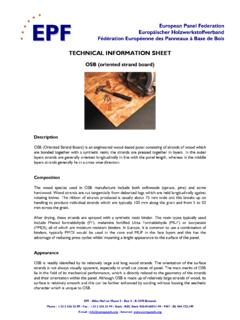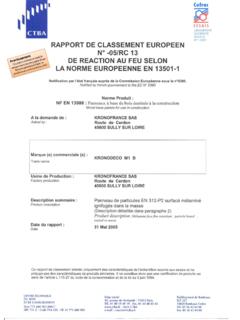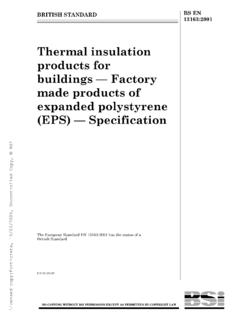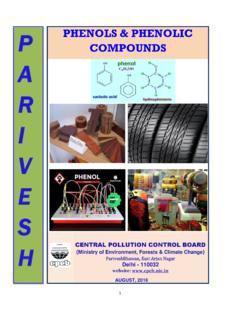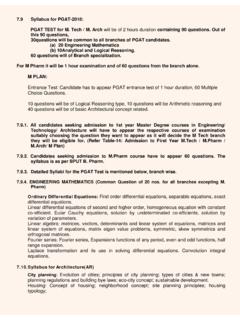Transcription of Fire Safety Briefing - EPS insulation
1 fire Safety Briefing - EPS insulation . fire Safety Briefing . Why EPS is the safe choice for building insulation The stages of a building fire The relevance of insulation in a building fire fire Safety of EPS by application CONTENTS. Page Executive Summary 3. 1 Effects and prevention of building fires 4. Stages of a building fire 4. fire prevention measures related to insulation 5. CE-Marking 5. 2 fire behaviour of EPS insulation products 6. fire behaviour of fire retarded EPS insulation products 6. Heat of combustion 7.
2 Toxicity of smoke from combustion of EPS 8. Obscuration by smoke 8. 3 fire Safety of EPS insulation products and insurance 9. Analysis of large fires (greater than 1million Euro damage) 9. Role of insulation in fire 10. 4 fire Safety of EPS per application 11. fire safe floors and foundations using EPS 11. fire safe wall using EPS 11. fire safe EPS steel sandwich panels 11. fire safe steel decks insulated with EPS 12. 5 Conclusion 13. References 14. 2. EXECUTIVE SUMMARY. A serious building fire is a disaster for those involved.
3 Not only is the potential for loss of life and catastrophic effect on business a major concern, so too are the increasing insurance premiums. In this document we address the role of insulating material in the fire Safety of buildings, with a special focus on EPS. We will show that, in a properly designed and constructed building, insulation material plays an insignificant role in fire Safety . Conversely, insulating material contributes enormously to energy savings for the heating and cooling of buildings. This is not only a financial saving but also a contribution to CO2 reduction and the prevention of global warming.
4 The unique properties of EPS make it the ideal, sustainable insulating material for many applications. The purpose of this document is to clarify the performance of expanded polystyrene foam (EPS) when used as insulation material. It provides an overview of the facts on fire safe constructions using EPS building products. All interested parties such as building owners, architects, builders, the fire service, insurers, risk managers and risk engineers should use it as an authoritative reference. Why is EPS the preferred insulation material?
5 Technical advantages Environmentally friendly Low weight, high compression Durable, because it does not degenerate . strength, excellent walkability through moisture, rotting, mould, UV.. exposure or compaction by vibration High insulation value, constant over time (without ageing effects, for example from Low environmental impact during . decreasing content of blowing agents production . and/or increasing moisture content).. Easily and completely recyclable . Easy, clean and safe to work with Free from formaldehyde, (H) CFC's Freedom to design practically any shape and other ozone depleting blowing agents.
6 By moulding or cutting . Closed cell foam, inert, biologically neutral Available in fire safe FR quality . Competitive price The most cost-effective insulation . Health and Safety aspects No irritation to skin, eyes or lungs from . released fibres or dust No personal protective equipment or clothing needed 3. 1 EFFECTS AND PREVENTION OF BUILDING FIRES. A fire can only start and continue to burn if three essential factors are present - the availability of combustible material, oxygen and a source of ignition. Normally, combustible material and oxygen are always available.
7 The third factor, a source of ignition, can be provided intentionally or unintentionally, by a flame, a spark, a cigarette or by an electrical short circuit. Stages of a building fire After flash over the chances of saving people or the contents of a room are minimal because of the A fire passes through a number of phases: ignition, temperature, lack of oxygen and damage to materials growth/development, fully developed and decay. Solid by heat and soot. Left to burn, a fire will eventually materials do not burn directly but give off combustible decay due to the lack of flammable material.
8 Gases when heated. It is the gases that burn. In the first phase of a fire , combustible gases develop and EPS starts to soften at a temperature of about 100 C, a build up while the temperature is still relatively low. temperature at which people already have minimal After some time there can be a rapid development of chance of survival. At this phase of a fire there is the fire : the flash over. An increasing number of hardly any oxygen left and the air is toxic because of elements reach their ignition temperature; the high levels of carbon dioxide and carbon monoxide.
9 Temperature then rises quickly from about 100 C to During the phase of rapid fire development, the flash 750 C. The accumulated gases ignite and the fire over, wood will self-ignite at a temperature of about spreads through the whole room. For humans, 340 C and EPS at a temperature of about 450 C. So temperatures above 45 C are uncomfortable; a the time for saving people and material is limited to the prolonged stay in a temperature above 65 C can first stage of a fire and this is independent of the cause damage to the lungs and people cannot survive insulation material.
10 EPS has a limited role in the design for long if temperatures are higher. After the of fire resistant constructions used to compartmentalise occurrence of a flash over, the fire reaches its full buildings. EPS should only be applied in such scale and further development is limited by the constructions in combination with other fire resistant availability of oxygen through ventilation. materials which perform the fire resistant role. Different phases in the development of a fire within a compartment Compartment temperature Stage 1 Stage 2 Stage 3 Decay stage Non-flaming Developing fire Fully decomposition developed fire 0 Ignition FLASHOVER Time t ISO TR 9122-1 [ref 1].


